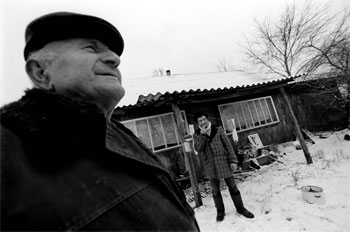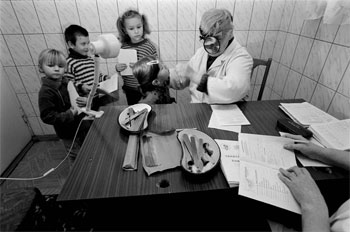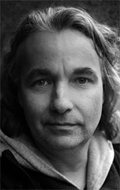At 1:24 a.m on April 26, 1986, the Chernobyl nuclear facility exploded during an attempt to increase the capacity of the reactor.
In 1996, 10 years later, I was standing outside the reactor in Chernobyl and the needle on the Geiger counter was still maxed out. I was 32 years old and a staff photographer at Aftonblade, the largest newspaper in Scandinavia, on assignment covering the 10-year anniversary of the Chernobyl catastrophe. The local authorities were only giving one-day passes. I wanted to do a comprehensive photo essay that would cause the viewers to react and to give them an understanding of the situation. Later, when I looked at my negatives my frustrations grew over the lack of material and the quality of the images. On my light table there were too few images that fit with the story I had hoped to do. I promised myself that I would return. It would take another 10 years. The radioactive fallout was 70 percent in southern Belarus: I knew that should be my starting point. In November 2005 I boarded a plane to Belarus.
 |
Belarus - Chernobyl, 20th Anniversary. Ivan Ivanovitj, 82, outside his home in the "Black Zone" of Belarus, on Sunday, Nov. 20, 2005. Ivanovitj feels he is still going strong, 20 years after the Chernobyl explosion. "I wrote to President Lukasjenko and asked for a tractor," he said, laughing. Ivanovitj is one of nine people who still live in the radioactive Black Zone of southern Belarus, where 70 percent of Chernobyl's nuclear fallout landed. Ake Ericson/WorldPictureNews |
Today 20 percent of Belarus is a forbidden zone. Arranging a trip to this part of the country took three months. Making a connection with the right contact took up much of the time. The journalist I was to travel with found a missionary in Minsk. He, in turn, got us in touch with a professor from Minsk University who would travel with us as unofficial guide and translator. I knew that we should seek credentials as students and not as journalists because had we announced that we were journalists we would have been assigned a guide who, in all probability, would not have taken us where we wanted to go.
We arrived in Khoinike, a village located 1 km outside the zone; from there I drove right into an invisible danger zone. The radioactive exposure from four hours here would equal six months of exposure in the rest of Europe. The guards took a long look at my credentials, but on the whole, the guards were cordial.
 |
Belarus - Chernobyl, 20th Anniversary. Slava Mozyrs and his father walk down a street in Strelichevo, Belarus, on Mon., Nov. 21, 2005. His father is a tractor driver, which is dangerous work since he sits uncovered behind the steering wheel. When harvesting, he cannot protect himself from inhaling radioactive dust, as the ground in Strelichevo is still contaminated, 20 years after the Chernobyl nuclear facility exploded. Ake Ericson/WorldPictureNews |
After the evacuation 20 years ago, the only measure authorities have carried out is to clear forest firebreaks. The nightmare scenario continues to be a forest fire in combination with a strong wind. Large amounts of radioactive particles would then spread their way to the capitol of Minsk and other densely populated areas. The population would be breathing in radioactive ashes and dust.
In planning the trip I had to take the time of year into account. We had to arrive when the chance of fires was low and gusts of wind were minimal. We knew the danger. In fact, there was a radiation meter in the vegetable market in Minsk. Both eating and breathing here over the long term was unhealthy.
The villages that used to exist around Chernobyl in Belarus lie abandoned inside what is called "the black zone." The houses have been leveled to prevent people from returning. Ghost streets sprawl between freestanding chimneys without homes. However, people find their way back. There are nine men and women who refused to move away from their homes and have been here for 20 years. "I can't see it, so it doesn't exist," Ivan Ivanovitj says about the radioactivity that surrounds him.
 |
Belarus - Chernobyl, 20th Anniversary. A local boy gets his thyroid glands examined by a doctor at a sanatorium outside Minsk, Belarus, on Thurs., Nov. 24, 2005. Children living in areas with the worst levels of radioactive fallout from Chernobyl, 20 years ago, are offered two "health trips" every year, one during spring and one in the fall. During these trips, the children stay at a sanatorium for 24 days. Scientists are counting on 12,500 new cases of post-Chernobyl cancer in the next 10 years. Ake Ericson/WorldPictureNews |
There is a cancer clinic in Minsk that is a home for those children that have become victims of the radioactivity that Ivan denies. Scientists are counting on 12,500 new cases of cancer in the next 10 years. The children are not just dying of cancer, they are also victims of leukemia, deformation and birth defects. At a sanitarium just outside Minsk, the children from the areas with the worst exposures are tested regularly. They are allowed to visit twice a year and they are fed nutritional meals and can play on untainted grounds. [In southern Belarus, 50 percent of the children were under 4 years old at the time of the disaster. In view of the pattern of cases reported to date, the World Health Organization (WHO) predicts that one third of all the children in this area will develop thyroid cancer during their lifetime-a total of 50,000 children in this group alone, according to information at the Web site
www.chernobyl.com.
Chernobyl lit a radioactive fire that burned for 10 days. It vomited 190 tons of toxic substances into the atmosphere. The radioactivity was the equivalent to 100 times the strength of the atom bombs dropped over Nagasaki and Hiroshima.
The images I came home with this time show a little more than my first attempt. At least they depict the ongoing affects of the catastrophe in the Black Zone near Chernobyl, where life has both stopped and still continues despite everything.
Swedish photojournalist Ake Ericson was born in 1962. His first photograph was published when he was 14 years old. He has worked as a photojournalist since the age of 18. After 12 years of working for various local newspapers in Sweden, he was hired by Sweden's largest daily newspaper, Aftonbladet, where he stayed for 10 years.
Since 2000, Ericson has worked as a freelance photojournalist. He has been working in many eastern European countries: Russia, the Balkans and especially in the Kosovo region. He has won several photo awards in Sweden. Ericson is affiliated with World PictureNews in New York and his work has been published in Paris Match, Le Figaro, Stern Magazine, Le Observateur and Le Monde. Today he lives in Stockholm with his wife and two sons.






